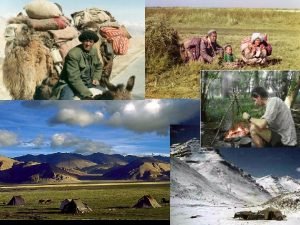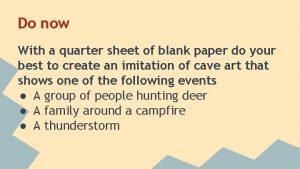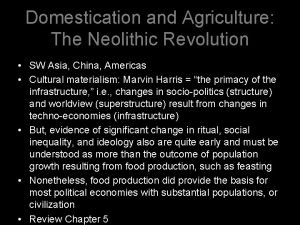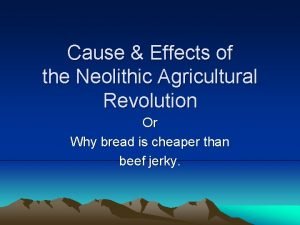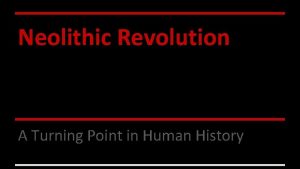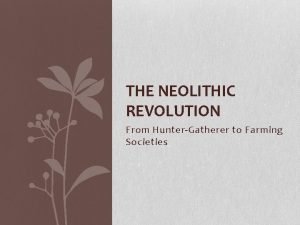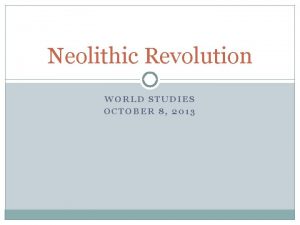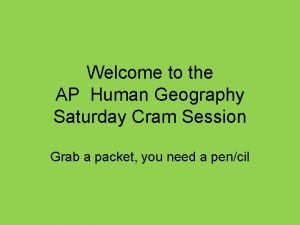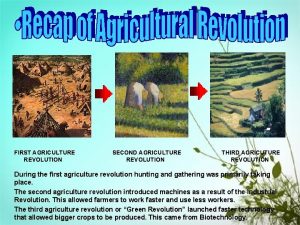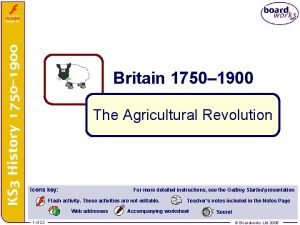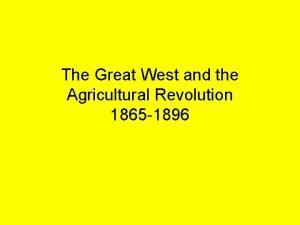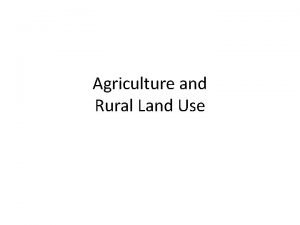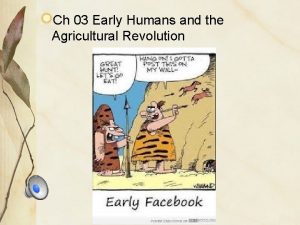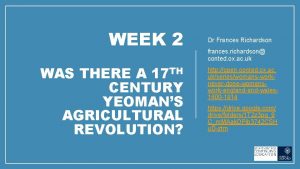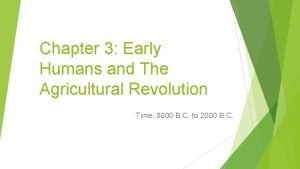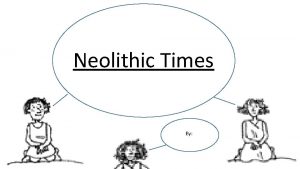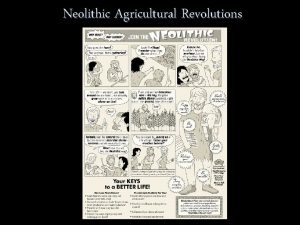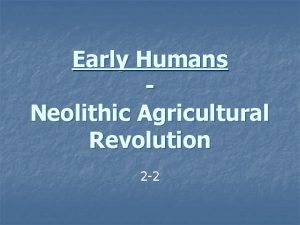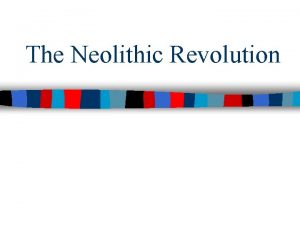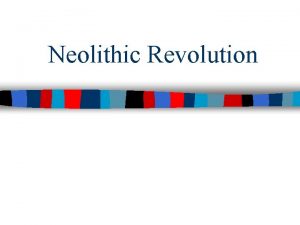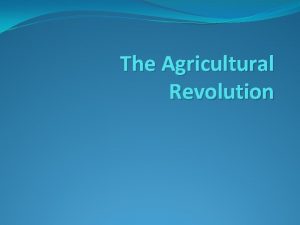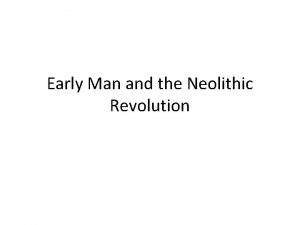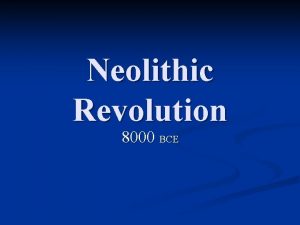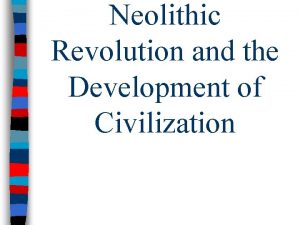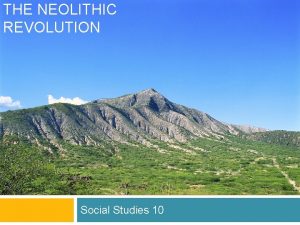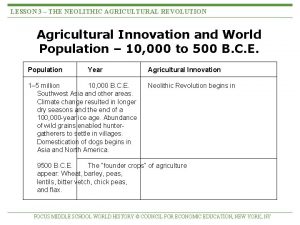Topic Neolithic Agricultural Revolution Overview The Agricultural Revolution



















- Slides: 19

Topic: Neolithic (Agricultural) Revolution Overview: The Agricultural Revolution was a change from hunting gathering to systematic agriculture. Farming led to the establishment of permanent settlements that eventually developed into the world’s first civilizations. Civilizations share common characteristics. Vocabulary and Terms Key Events and People tools hunters/gatherers Systematic agriculture settlement domestication pastoral nomads irrigation civilization Neolithic Revolution ( causes and results) Causes: Change in weather, increase control of Their environment, Domestication of plants and animals. Results: Increase population, settlements and civilizations Characteristics of a Civilization Religion Government Cities Public Works Economic Systems Writing Different jobs Social Classes

Topic: River Valley Civilizations Overview: Farming Communities often developed along river banks. As the river banks flooded and carried silt onto the land, the land became more fertile. The River also allowed for transportation and communications. River valley civilizations developed in Mesopotamia , Egypt, India and China Vocabulary and Terms Mesopotamia Ziggurat Cuneiform Nile Hieroglyphics Pharaohs Royal Road City-state Dynasty Cultural diffusion Empire Key Events and People Identify the contributions of various river valley civilizations including: Sumer- plow, wheel, number sys based on 60, sun dial, pottery wheel, use of Bronze Phoenicians-22 letter alphabet Babylonians – Hammurabi (Hammurabi’s code) – first written set of laws Israelites- 10 commandments Persians- expansion of trade, silk road : cultural diffusion Egyptians- papyrus, mummies, pyramids, hieroglyphics

Topic: Greece and Rome Overview: The political and cultural beginnings of the classical societies of Greece and Rome laid the foundations for future development. They left a large imprint that other civilizations would copy or revise. Their influence on law, politics, art, architecture and science are still seen today. Vocabulary and Terms Empire Democracy Diffusion polis Oligarchy Philosophy Epic poem Triumvirate Patrician Plebeian Key Events and People Greece Establishment of early city states-independent due to geography, Minoans, Mycenaean Greek Philosophers-Socrates, Plato and Aristotle Persian wars Greeks v Persians, Greek city states form alliance called Delian League- Leads to golden age of Athens Age of Pericles –expansion of arts and culture, Direct Democracy The Great Peloponnesian War Sparta v Athens, weakened the major Greek estates led to rise of Macedonian Hellenistic Era under Alexander-the Great Expansion of Greek language and ideas the non Greek world in SW Asia and beyond

Topic: Greece and Rome (continued) Key Events and People Rome Greek influence-art, architecture, religion The Republic –leader is not a monarch & citizens have the right to vote Roman Law- 12 Tables Society –Paterfamilias (male dominated society), patricians ( wealthy land owners) and plebeians (less wealthy land owners) Architecture- dome, arch, aqueducts road systems Punic Wars- Rome v Carthage- Rome becomes dominant power in The Mediterranean First Triumvirate –fall of the Republic- Caesar becomes dictator Second Triumvirate- The Beginning of the Roman Empire, Caesar Augustus declared imperator Pax Romana (Roman Peace) – period of peace and prosperity lasting almost 100 yrs Constantine- first Christian emperor, founded Byzantium later known as Constantinople. Influence on government Republic Democracy Branches of government Rights and responsibilities of the citizens

Topic: India and China Overview: Early civilizations in India and China were among the first to deal with the problems of governing large populations. Both countries enjoyed rich cultural traditions and many of their technological innovations were adapted by other peoples. Hinduism and Buddhism are now practices by people around the world. Vocabulary and Terms: Key Events and People: India: Monsoon Sanskirt Raja Caste system Reincarnation Untouchables Silk Road Mandate of Heaven Dao Filial piety Aryans-Indo Europeans nomads who will conquer the Indian peninsula and created a new Indian society based on their culture and traditions. They are responsible for the Caste System Siddhartha Gautama- Buddha Asoka-Ruler of the Maurayan Dynasty: he ruled using Buddhist ideals as a guide. Huns- invaders from northwest who caused the decline of the last Indian Kingdom China: Shang-ancestor worship, division of classes, writing system, use of bronze and silk Zhou-Mandate of Heaven Qin- (Qin Shinhuangdi first emperor) unify China, money system, roads, great wall for protection Han-Civil Service, cast iron, water mills Tang-gun power Song-movable type

Topic: World Religions Overview: Integral to the growth of many civilization is the development of belief systems that address questions of ethics, morality, spirituality, and the possibility of an afterlife. Religions provide societies with a since of unity, pride, and inspiration. Missionary activity has often led to dynamic and fruitful interactions across cultures. On the other hand, clashes between different faiths have resulted in bigotry, persecution, and war. Judaism: covenant with Yahweh (God) follow law and he will deliver them to promise Monotheistic land , Prophets : Abraham, Moses. Holy Book: Torah, Ten Commandments Christianity: believe in one God and that Jesus is the savior son of God, Prophets: Peter and Paul, Holy Book: Bible, Ten Commandments and Cannon law Islam: Allah (God) is all powerful. He created the universe and revealed his word to Muhammad his prophet. Holy Book: Quran, 5 Pillars, Sharia’h (book of law) Sikhism: spiritual union with God leads to salvation, combines Hindu and Muslim ideas Based on the teachings of Guru Nanak Dev, 5 K’s Hinduism: Soul should seek ultimate reality, Believe in reincarnation based on karma Polytheistic Philosophy (peoples actions) in relation to Dharma (divine law), Vedas- book of ceremonies and traditions Buddhism: Once people let go of their worldly cares, pain and suffering will be forgotten, goal is to achieve nirvana, Four Noble Truths ( message) , Eightfold Path ( rules to live by), Siddhartha Gautama - Buddha Confucianism: there is a assumption that the universe has an order, if we focus on the five relationships ad do what is right we will preserve the order. Founder: Confucius, Five Relationships, strong work ethic

Topic: Muslim World Overview: The cultural, artistic, and scientific contributions of Muslims continue to enrich our daily lives and more than one billion people around the world are Muslims who follow the teachings of the Quran and Islam is one of the world’s leading faiths. Vocabulary and Terms: Muslims – Those who worship Allah and recognize Muhammad as the last Prophet Mecca – The Holy City of the Islamic faith Allah – Monotheistic deity; also recognized as the God of Abraham (Yahweh) Hajj – Pilgrimage to Mecca that each Muslim is required (health permitting) to take within their lifetime Jihad (Holy Struggle) – The expansion of the Islamic state and control Key Events and People Muhammad – Born in or about 570 and is considered the founder of Islam Trade and spread of religion – Silk roads, European exploration, slave trade Development of Islamic caliphates Abbasid caliphate: Baghdad Fatimid caliphate: Cairo Umayyad caliphate: Damascus Shi’a movement begins as a reaction to Umayyad rule Expansion of Islam into North Africa and Spain Golden age in mathematics and science, including chemistry, empirical scientific method, and medical care Mongol invasions

Topic: Byzantine Empire and The Middle Overview: The Byzantine Empire became the seat of the Eastern Ages Orthodox Church and developed its own unique civilization. During, the early Middle Ages (age of faith), Europe experienced a revival of trade, and a confident Catholic Church. However, it also saw tragic setbacks in the form of plague, economic collapse, and war. Christianity remained a focus of European life, but centuries of disagreements with the monarchies left the Church weakened. Key Events and People Feudalism – Reciprocal military obligations between members of the warrior nobility in Medieval Europe Characteristics – Lords grant parcels of land known as fiefs to lesser knights who are known as vassals, who in turn, provide military service to the lord. Chivalry and fealty between a lord and the vassal relationship Contributing factors – Fall of the Roman Empire leaves a gap in protection and services to people, invaders overrun communities, people turn to lords for their protection Manorialism – Smallest economic, social unit revolving around an estate, controlled by a lord, who gives land protection to his serfs, who in turn give him their services. Manors were self-sufficient where serfs raised and produced nearly everything needed for that community. The open field system allowed several families of serfs to farm strips of the same parcel of land. Living conditions for serfs were generally harsh on manors. Contributing factors – Model of villas in the Roman Empire used to manage rural economies; decline in overland sea trade after the fall of the Roman empire as well as threats from invaders also promoted the self-sufficiency of a manor

Topic: Byzantine Empire and The Middle Ages(continued) Crusades – Series of religious expeditions to regain the Holy land Failure lessened the power of the Pope Casualties weakened the feudal nobility Trade in spices and other goods from Southwest Asia lead to European desire for new trade routes that begins the Era of Exploration Black Death- Bubonic Plague: spread through out all of Western Europe and killed 38 million people Collapse of manorial system as productivity ends and serfs leave in search of work; peasant rebellions grow in response to nobles’ refusal to increase wages Church loses prestige as it is unable to stop the plague through prayer and intervention 100 Years War- War between France and England. The kings of both countries claimed right to the French crown Emergence of nationalism and monarchs as national leaders in England France Instability in England after the Hundred Years War leads to the War of the Roses, which strengthens Parliament since it is called frequently by King Edward III to increase taxes to finance this new war; democracy advanced as Parliament gains greater “power of the purse” Great Schism: Split in the Catholic Church as two popes claim authority – one in Avignon and the other in Rome; both excommunicate each other from the Church Authority of the pope as head of the Church challenged by John Wycliffe, who believes that God is sole authority, and Jan Huss, who believes the authority of the Bible is higher than the pope’s authority. Beginning of challenges to the authority of the Catholic Church that leads to the Reformation.

Topic: Renaissance and Reformation Overview: The Italian Renaissance introduced Europe to a secular worldview and a boom in artistic and intellectual development. Intellectual change led to Christian humanism. The Reformation was a break with the Catholic Church and the birth of Lutheranism. Renaissance Humanism focuses on human potential and achievements through the study of classical texts Popular subjects from classical civilizations like history, literature, and philosophy revived and known as the humanities Secularism – less emphasis on religion with a more worldly view concerned with the here and now Invention of the printing press spreads new ideas New techniques in perspective make art and sculpture more three-dimensional than Medieval Art Renaissance masters- Leonardo, Michelangelo and Raphael Reformation Europe becomes politically fragmented along religious lines and nations align themselves as either Catholic or Protestant Unity in Europe as a Christian society was shattered by the different conflicts that erupted between Protestants and Catholics Catholic Counter – Reformation is a response to the Protestant Reformation Vernacular translations of scriptures allowed ordinary people to read the Bible and explore the truths of God for themselves. Protestantism gave people a new sense of coming to God without the intervention of the Church and priests Persecution of perceived heretics in both the Catholic and Protestant churches Use of the Inquisition courts in Catholic Spain

Topic: The Enlightenment and The Scientific Revolution Overview: The Scientific Revolution challenged how people view the universe using experimentation, observation and scientific reasoning to gather knowledge about the physical world. The Scientific Revolution also gave rise to an intellectual movement the Enlightenment (Age of Reason). The Enlightenment thought provided the philosophical foundations for the American Revolution. Britain lost its colonies in North America to the newly formed United States, while Spain and Portugal held onto their profitable Latin American colonies. Key Events and People Copernicus proposed theory that the Sun, not the Earth, was the center of the solar system in 1507, and that the earth was really insignificant in the context of the universe. Galileo developed and applied scientific principles that significantly increased astronomical understanding. In 1613, he proved Copernicus’ theory that the Sun was the center of the solar system. Sir Isaac Newton - An English mathematician and physicist who devised principles to explain universal gravitation, that all matter attracts other matter. He adapted the ideas of Galileo Galilei into three laws of motion including “for every action there is an equal and opposite reaction. ” Robert Boyle - English physicist and chemist who discovered the nature of elements and compounds, the basis of modern chemistry John Locke – Governments have a contract with the people, by a more positive attitude about the people’s ability to choose a government. Hence, within Locke is the belief that governments must protect their citizen’s life, liberty and property; and should they fail to do so they can and should be replaced. Thomas Hobbes – Men should put their faith (or create a contract) in a government to provide stability for their lives, since people have lives that are “cruel, nasty, brutish and short. ” Voltaire – Advocacy of civil liberties including tolerance, freedom of religion, and freedom of speech Charles de Montesquieu – Power should be balanced between three branches of officials (separation of powers) Jean Jacques Rousseau – The general will, usually defined as the majority, should determine the laws of the nation

Topic: Exploration & the Americas Overview: In the fifteenth century, Europeans set out on a series of overseas voyages that would lead to the establishment of European trading posts and colonies in both the Americas and the East. Religious zeal, a quest for personal and national glory, and a desire for new wealth were the chief motives behind the European voyages. New technologies and the growing power of the European monarchies made the voyages possible. The Spanish colonization of the Americas was extremely rapid and devastated native American civilizations. Colonization of the globe led Portugal, Spain, the Dutch Republic, England, and France to new economic heights. International trade increased, and a new economic theory—mercantilism—was born. Vocabulary and Terms Key Events and People Mercantilism prosperity of a nation depends on its Supply of gold and silver Encomienda system land granted by king Mestizos european and indian decent Columbian Exchange-exchange of goods between the Americas and Europe Middle Passage middle point of triangular trade, journey of Africans to America Causes of European expansion: God, Gold and Glory Effects of European expansion: colonization and Imperialism Hernando Cortes-conquest of Mexico: Aztecs Francisco Pizarro – conquest of the Incas in Peru

Topic: Exploration & the Americas Maya Astronomy – Observe the movement of the sun, moon, and stars and relate these to the activities of their gods Mathematics – 260 day religious calendar, concept of zero Architectural engineering – Elaborate pyramids, temples, and ball courts Aztec Astronomy and Mathematics – Ceremonial calendar Architectural engineering – Tenochtitlan designed as a planned city constructed on an island with raised causeways to the mainland; aqueducts to bring fresh water to the city; elaborate temples, palaces, and pyramids Incas Astronomy – Two separate calendars for the day and night Mathematics – Accounting device known as a quipu (knotted strings); decimal system incorporated in system of governing Architectural engineering – Elaborate temples and palaces Machu Picchu, extensive road system, uniform system of architecture for government buildings in the empire

Topic: Political Revolutions American Revolution (1775 -1783) Causes • Ideas from the Glorious Revolution – limited monarchy, English Bill of Rights • Ideas from the Enlightenment – all people have rights and governments are responsible for protecting these rights; people have the right to remove governments that fail to do so • Desire to participate in parliament • British polices related to the American colonies, especially concerning the imposition of taxes • The Americans declared independence in the Declaration of Independence expressing ideas about liberty, equality, and democracy. Consequences America became independent U. S. Constitution The Bill of Rights The success and ideas of the American Revolution inspired the French Revolution (1789 -1795) Causes Influences from the Enlightenment and the American Revolution Inequality in the class system (1 st, 2 nd, 3 rd estates) Abuses of the nobility and the kings Debt and high taxes Crop failures cause the price of bread to rise beyond the ability of the peasants to pay (starvation) Consequences The “Declaration of the Rights of Man” was published A Parliament was established and peasants were freed King Louis XVI and Marie Antoinette were beheaded along with others during the Reign of Terror Chaos in government resulted in Napoleon and the army coming to power and creating the French Empire

Topic: The Industrial Revolution Overview: The Industrial Revolution began in the late eighteenth century and turned Great Britain into the first and the richest industrialized nation. A series of technological advances caused Great Britain to become a leader in the production of cotton, coal, and iron. After the introduction of the first steam-powered locomotives, railroad tracks were laid across Great Britain, reducing the cost of shipping goods. The Industrial Revolution spread to the rest of Europe and North America. In the United States, the railroad made it possible to sell manufactured goods from the Northeast across the country. The Industrial Revolution had a tremendous social impact in Europe. Cities grew quickly, and an industrial middle class emerged. The industrial working class, meanwhile, dealt with wretched working conditions. These conditions gave rise to socialism, a movement aimed at improving working conditions through government control of the means of production. Agricultural Revolution – enclosure system that allowed for cultivation of larger fields, Jethro Tull’s seed drill, crop rotation, new methods of breeding livestock – all lead to a population increase, less labor intensive, and land displacement of smaller farmers who move to cities and begin working in factories New inventions in the textile industry –flying shuttle, spinning jenny, spinning mule, water frame – modernize the cotton and textile industry Factory system that is used for the housing of large machinery Steam engine as a source of power – James Watt Steamboat makes water transportation easier – Robert Fulton (American) Railroads Creation of the factory system that led to mass production of goods Long work hours, low wages, and dangerous working conditions for industrial workers Class tensions between the upper/middle classes and the working classes Increase in child labor which later led to child labor reform laws Poor housing conditions for workers that result in poor sanitary conditions and health epidemics

Topic: Imperialism Overview: The search for sources of raw materials and markets for industrial products spurred the European powers and the United States to colonize large areas of Asia, Africa, and Latin America. Resentment of abuses and rising nationalism led native populations to demand independence. Vocabulary and Terms Colony – governed internally by a foreign power Protectorate – country with its own internal government but controlled by an outside power Sphere of Influence – area claimed by an outside power for exclusive investment and trading Economic Imperialism – independent countries controlled by private interests Indirect control – colonies with local government officials with limited self-rule; laws based both on European styles and local rules Direct control – colonial governments with exclusive use of foreign officials with no self-rule; laws based only on European law; policies of assimilation to absorb local cultures into European culture Key Events and People Negative consequences 1. Native people lose control of their lands and independence 2. New diseases like smallpox reduce native populations 3. Resistance movements, famines resulting from shifts to cash crop production, and harsh working conditions also reduce native populations 4. Problems of identity as westerners contemptuously view native cultures 5. Areas stripped of natural resources Positive consequences 1. European military presence reduces local warfare 2. Humanitarian efforts improve sanitation and education that leads to growth in life expectancy and literacy 3. Colonial lands equipped with infrastructure to aid in economic growth 4. Products from colonies valued in the international markets

Topic: World War I Competition over trade and colonies led to the formation of two rival European alliances—the Triple Entente of Great Britain, France, and Russia; and the Triple Alliance, consisting of Germany, Austria-Hungary, and Italy. Austria-Hungary, as well as numerous other European governments, confronted challenges from minorities who wished to establish their own national states. Strikes and violent actions by Socialist labor movements also threatened European governments. Many European states responded with increasing militarism and nationalism. The assassination of the heir to the throne of Austria-Hungary by a Bosnian Serb militant set off a chain of diplomatic and military decisions that led all of the great powers of Europe into World War I. Vocabulary and Terms Alliance Militarism Nationalism Trench warfare Mobilization Fourteen Points- President Woodrow Wilsons plan for peace, includes the League of Nations-peace keeping organization Key Events and People Causes Imperialism: European nations compete for colonies Nationalism – Competition for industrial dominance develops between Great Britain and Germany; territorial disputes over Alsace-Lorraine promote rivalry between France and Germany; Austria-Hungary and Russia compete for dominance of the Balkan Peninsula, where independence movements of various Slavic people develop. Militarism – Increasing nationalism led to a European arms race; Alliance System – Alliances between the great powers of Europe were complicated and shifted constantly Impact Trench war fare and new weapons lead to millions of deaths Treaty of Versailles – sole responsibly for war placed on Germany

Topic: World War II Overview: Aggressive moves by Germany and Japan set the stage for World War II. In 1935, Adolf Hitler began a massive military buildup in violation of the Treaty of Versailles. When Hitler signed the Nonaggression Pact with Stalin and invaded Poland, Britain and France declared war on Germany. German forces swept through central and northern Europe early in the war. Meanwhile, the United States followed a policy of isolationism. In the east, harsh weather and a resolute Soviet Union defeated an invading German army. The Japanese conquered the Pacific but miscalculated when they attacked the U. S. naval base at Pearl Harbor. The United States surprised Japan by abandoning its neutrality and entering the war to retake the Pacific. By the end of 1943, the tide had turned against Germany, Italy, and Japan. After the invasion of Normandy, the Allies liberated Paris and defeated Germany. The war in Asia continued until the United States dropped atomic bombs on the Japanese cities of Hiroshima and Nagasaki, causing massive casualties and bringing Japan's surrender. Events and People Vocabulary and Terms Key Japanese imperialism: Plans for a Pacific empire that Fascism Totalitarianism Axis Germany, Italy Japan Allies U. S. Britain, Soviet Union Blitzkrieg (“lightning war”) incorporates fast-moving airplanes and tanks. The Holocaust: Genocide of over 6 million Jews and other groups throughout Europe considered by Germany to be inferior. Known as “The Final Solution” and resulted in the extermination of these people in death camps. Containment After WW 2 policy to contain or stop the spread of communism in the world included China that would allow Japan to solve its economic problems through the provision of raw materials and markets for its goods as well as providing more room for its growing population. Attack on Pearl Harbor (December 7, 1941) by Japan leads the United States to declare war on Japan. This results in a declaration of war on the United States by Germany and Italy. Normandy landings (June 6, 1944 – “D-Day”) by Allied forces on the coast of France lead to a German retreat. As a result, France and the Low Countries are liberated and Allied troops push eastward into Germany that leads to German surrender in 1945. Dropping of atomic bombs (August 6 and 9, 1945) by U. S. on Japanese cities of Hiroshima and Nagasaki leads to Japan’s surrender.

Topic: Cold War Era Overview: Tensions between western nations and Communist governments following WWII. In 1947, America implemented a policy of containment that provided economic support to vulnerable countries as way to prevent them from falling under communist rule. Soviet satellites in Eastern Europe lead to the Iron Curtain (1945 -1948) Truman Doctrine (1947) – U. S. aid to Turkey and Greece to prevent spread of communism (containment) Marshall Plan (1948) – U. S. aid to Western Europe for war recovery and prevention of spread of communism Berlin Airlift (1948) – aid by air to Soviet-blockaded Berlin Communist takeover of mainland China by Mao Zedong (1949) Creation of North Atlantic Treaty Organization (NATO) (1949) between Western European countries and the United States as a defensive military alliance Korean War (1950 -1953) that leaves a divided Korean peninsula – North Korea (communist) and South Korea (democracy) Creation of Warsaw Pact (1955) between U. S. S. R. and Eastern European satellites as a military alliance Arms Race- Development and testing of hydrogen bomb by U. S. (1952) followed by Soviet H-Bomb (1953) Vietnam War (1953 -1975) that results in communist-backed North Vietnam overtaking U. S. -backed South Vietnam Launching of Sputnik satellite by Soviet Union (1957) Cuban revolution led by Fidel Castro that leads to communist takeover of that country (1959 -1960) Berlin Wall is built to divide the city into communist East Berlin and free West Berlin (1961) Cuban Missile Crisis between U. S. and U. S. S. R. that almost leads to nuclear war (1962) Civil war in Nicaragua that leads to communist-backed Sandinistas taking over the government (1979) Civil war in El Salvador that leads U. S. to back anti-communist forces known as the Contras (1980 -1992) Election of Mikhail Gorbachev in U. S. S. R. leads to political and economic reforms – Glasnost, Perestroika (1985) Fall of Berlin Wall (1989) and end of communist governments in Eastern Europe (1989 -1990) Reunification of Germany (1990) Yeltsin overthrows Gorbachev in a coup and U. S. S. R. breaks up (1991)
 Third agricultural revolution definition
Third agricultural revolution definition What was the neolithic revolution? *
What was the neolithic revolution? * Neolithic revolution
Neolithic revolution Chapter 3 lesson 2 the agricultural revolution
Chapter 3 lesson 2 the agricultural revolution Neolithic revolution
Neolithic revolution Cause and effect of the agricultural revolution
Cause and effect of the agricultural revolution Characteristics of new stone age
Characteristics of new stone age Why was the neolithic revolution a turning point
Why was the neolithic revolution a turning point Neolithic revolution definition
Neolithic revolution definition Whats neolithic revolution
Whats neolithic revolution Four tigers definition ap human geography
Four tigers definition ap human geography Neolithic revolution
Neolithic revolution Agricuture jobs
Agricuture jobs Agricultural revolution worksheet
Agricultural revolution worksheet The great west and the agricultural revolution
The great west and the agricultural revolution Whittlesey agricultural regions
Whittlesey agricultural regions Early humans and the agricultural revolution answer key
Early humans and the agricultural revolution answer key The agricultural revolution
The agricultural revolution Early humans and the agricultural revolution
Early humans and the agricultural revolution What crop started the third agricultural revolution
What crop started the third agricultural revolution

